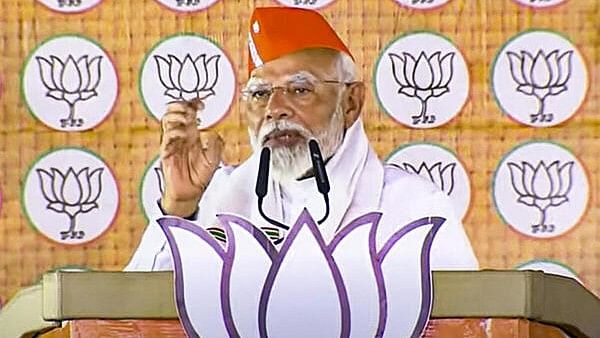
Prime Minister Narendra Modi addresses a public meeting for the Lok Sabha elections, in Surguja district, Chhattisgarh, on April 24.
Credit; PTI Photo
We are currently amidst a prolonged campaigning period for the Lok Sabha polls. While it is expected that campaign rhetoric at lower levels becomes personal with attacks on adversaries’ personas, it is sad to see national leaders, including those in positions of power, stopping to such lows in their campaign speeches against their political rivals. It’s saddening that instead of addressing the serious issues faced by the people, the Prime Minister seems to take pleasure in attacking the Congress Party, particularly Rahul Gandhi, endlessly.
Modi’s latest statement, suggesting that if the Congress party were to come to power, it would give away people’s properties and gold to Muslims, shows the depths of negative campaigning. Such speeches fuel hatred towards the minority community. Earlier, he labelled the Congress manifesto as a Muslim League manifesto. PM Modi should refrain from making such statements, as they are unlikely to resonate with average Hindus and Muslims, who coexist in peace.
Well, Rahul Gandhi hasn’t been much different. Recently, he talked about the possibility of societal unrest (referred to by the BJP as talking about bloodbath) if the BJP were to return to power.
This leads me to the manifestos of both the BJP and the Congress. The BJP manifesto, called the ‘Sankalp Patra,’ was launched on April 14 on the occasion of Ambedkar Jayanti. The Prime Minister dedicated it to the four castes he often mentions: the youth, women, poor, and farmers, as if the BJP doesn’t factor in caste at all in ticket distribution as part of its electoral strategy.
At the outset, it must be noted that the BJP manifesto can be justifiably described as the Modi Manifesto, as every issue it touches upon is described as ‘Modi Ki Guarantee’. The manifesto is too generic in nature. On every issue, the manifesto talks about what will be done if the party is voted back to power. For example: (1) We will continue to increase MSP periodically while remaining committed to providing sustained financial support to farmers. (2) We will expand seamless access to social security benefits and other essential services for senior citizens. (3) We will ensure a review of national floor wages from time to time. (4) We will work towards the elimination of malnutrition among tribal children to provide health services in a mission mode. While the term ‘ Viksit Bharat’ occupies a prominent space in the party manifesto to make India a global manufacturing hub by 2030, it has references to bringing the Uniform Civil Code, making the One Nation, One Election a reality, etc. Since the manifesto is in generic terms, PM Modi should, in his campaign speeches, be talking in detail as to how his party, if returned to power, would implement the various aspects of its Sankalp Patra.
The Congress Party’s manifesto, described as ‘Nyay Patra,’ emphasises that the ‘Constitution of India shall remain its sole guide and companion’. It focuses on saving democracy, ensuring freedom from fear, equity, and social justice. It pledges to uphold the rights of religious and linguistic minorities, practices true federalism with a focus on the rights of the states, and its commitment to the implementation of the MGNREGA and the National Food Security Act of the UPA era. It also promises a nation-wide caste census, 10% reservation in education, and jobs for economically weaker sections.
Among the guarantees, the manifesto refers to providing Rs 1 lakh a year to the apprentices, filling up 30 lakh vacancies in sanctioned posts in the central government, and restructuring start-up funding to promote self-employment. It also has the ambitious idea of providing Rs 1 lakh per year to the women of poor families under the ‘Mahalakshmi’ scheme by identifying the families at the bottom of the income pyramid.
As regards the farmers, the manifesto underlines the party’s commitment to providing legal guarantees to the MSP, to be announced by the government every year as recommended by the Swaminathan Commission, besides appointing a permanent commission on agricultural finance and farm and farm-specific crop insurance. Very relevant aspects indeed.
It is crucial that during the remaining campaign phases, Congress leaders Mallikarjun Kharge and Rahul Gandhi not only highlight the various aspects of the party’s ‘Nyay Patra’ but also explain to the electorate how they intend to raise resources to fulfil their promises.
Needless to say, BJP and Congress leaders should raise the standard of their campaign speeches.
(The writer is a former Professor of Political Science, Bangalore University)